
We all know what a movie musical is supposed to be. There’s an expectation that most of the story is going to unfold with the support of catchy and emotional songs, and in most cases some incredibly well choreographed dancing as well. But, not all of the best musical moments that have come from cinema are found in musical movies. Sometimes there are moments where a magnificent musical number will suddenly break out in a movie that beforehand had none and will not have any thereafter. And these unexpected musical treats can sometimes be among the most memorable moments ever in film. You find these moments mostly in a comedy, where the joke usually is the unexpected break into a musical number. Other times, the moment just springs out of the scene naturally, with the characters feeling the mood of a particular song that is playing within earshot and they either break out into a dance or sing along. In any case, these scenes reinforce the power that music can have when it’s in the service of storytelling, and all it can take is just one song to do it. For this article, I will be counting down what I think are the best musical moments from non-musical movies. To make it on this list, the movies themselves have to specifically be not in the musical genre. The movies can have more than one song in it, but the moment itself has to be one that is essential to the scene that it’s in; so no needle drops as part of the musical score. The characters in the moment have to be actively participating in the music or reacting to it. There are actually a surprisingly large amounts of great musical moments like these found in non-musical movies, so narrowing it down wasn’t easy. And so with that, let’s take a look at my picks for the Top Ten Musical Moments From Non-Musical Movies.
10.
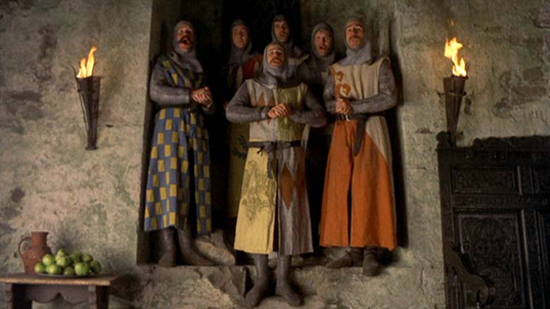
MONTY PYTHON AND THE HOLY GRAIL (1975)
“Camelot”
Remember when I said that many comedies will throw in a musical number as joke, intended to make fun of other musicals. Well, here is one of the best examples. Like most of the jokes found in this classic comedy, the musical number comes completely out of nowhere and blindsides you. Where it falls within the story is after King Arthur (Graham Chapman) has assembles all of his Knights of the Round Table, played by all of the other Monty Python members. Their journey begins as a search for a kingdom, and of course they arrive at the mythical Camelot (It’s only a model). Arthur orders his knights to follow him there and we immediately jump into the musical number in all of it’s lunacy. In typical Python fashion, the “Camelot” song is utter nonsense with the singers desperately straining themselves to rhyme words with Camelot. At the same time, we see knights dancing in a chorus line, knocking plates off tables and a page using their metal helmets as a percussion instrument. Even a cat getting stepped on becomes part of the musical bridge. And the funniest part is that the scene contributes nothing else to the story other than to convince Arthur and his knights to leave Camelot, because “tis a silly place.” It’s a fun, absurdist diversion that stands out in a movie that is full of absurdity. Eric Idle, one of the Monty Python members who co-wrote the song, would take the joke further by actually creating a full stage musical called Spamalot based on the film Monty Python and the Holy Grail itself, which became a huge success on it’s own. It’s easy to think that this small like musical number meant as a gag may have itself gone full circle and sparked into existence a who musical. That in itself is funny when you think about it.
9.

BIG (1988)
“Heart and Soul” and “Chopsticks”
Sometimes you don’t even have to sing to create a great musical moment. This is the case with this memorable scene from the movie Big. The movie that centers around a teenage boy who makes a wish to grow bigger and the next morning finds himself in the body of an adult man (played by Tom Hanks) offers plenty of potential for comedic hijinks. But, director Penny Marshall and screenwriter Gary Ross also managed to find a lot of heart in this story as well, giving it an emotional coming of age resonance. A lot of the film’s best moments come out of Tom Hanks’ performance, where you see him not only convincingly playing a child in a man’s body but also someone who is learning to grow up at the same time. That balance between becoming more mature while still having that childish sense of playfulness is perfectly captured in this scene, where Hank’s character is trying to connect with the owner of a major toy company that he works for, played by Robert Loggia. They unexpectedly stumble upon a floor piano display and Hanks’ character’s childish instincts kick into gear. He begins to play “Heart and Soul” by tapping his foot on the right keys and as he gets more into it, the piano playing becomes more of a dance. He somehow manages to convince the senior business owner to jump in, and he too starts to feel a little bit like a child again. It’s a simple but charming scene that just springs naturally out of the moment, and uses music as a great story-telling tool to show human connection. It helps that it looked like Hanks and Loggia were having fun while filming the scene. Indeed, the two made an effort to make the scene work, as there were apparently back up dancers on set in case they missed a note or two. Neither missed a step and the stand-ins were never needed. Just a sublimely charming use of music in a movie that otherwise is just a comedy.
8.
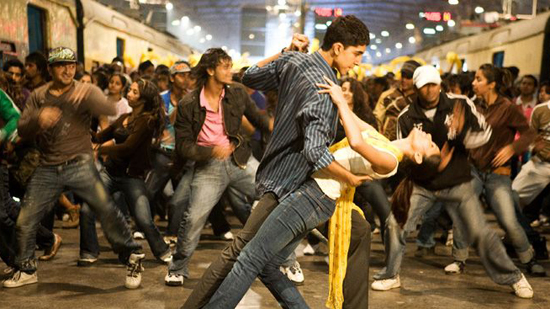
SLUMDOG MILLIONAIRE (2008)
“Jai Ho”
This Oscar winning film on the surface seems to be a film deeply rooted in the country of India. But, when you look at the team behind it, it’s actually a British made film, from the director to the screenwriter to many of the key positions behind the camera all being filled by people who are distinctly not Indian. But the film does make an effort to draw inspiration from the subcontinent’s vast cinematic history. Bollywood after all is the second largest film industry in the world behind Hollywood, and even in recent years it has begun to catch Tinseltown by surprise. The film Slumdog Millionaire is for the most part a straight forward drama about a young man named Jamal (Dev Patel in a star making role) trying to survive as an orphan and societal cast-out, only to take all of that struggle and learn from it and have it help him win millions of dollars on a trivia game show. In many ways, the straight forward approach to the drama separates the movie from it’s Bollywood contemporaries. That is until the finale though. After the story comes to a close, and Jamal ends up a millionaire and with the girl he loves (played by Frieda Pinto), the credits begin to roll and suddenly the movie breaks into a full blown Bollywood musical number. It’s a brilliant move to wait until the very end for the movie to spring this on us; it would have felt out of place anywhere else, which sometimes is something that Bollywood filmmakers are not concerned about. The musical number in the end feels earned and is something of a victory lap for the film. It helps that it feels tied into the story as well, as it takes place in a train station that was a key meeting place for the characters, both as children and as adults. The movie brilliantly includes shots of the child actors who played the younger counterparts of the leads also dancing. The song won composer A.R. Rahman an Oscar. Over a decade later, a true Bollywood film would win the same award with the hit song “Naatu Naatu” from RRR (2022). Slumdog may not have been a true Bollywood musical in the same sense, but it use the Bollywood style to give us one hell of a closing note to leave the movie on.
7.
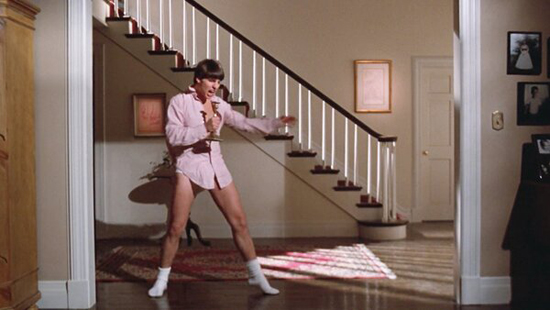
RISKY BUSINESS (1983)
“Old Time Rock and Roll”
Sometimes a great musical moment can happen in a movie when a character just feels the vibe in the moment when a song comes on. In this iconic scene from Risky Business, Tom Cruise’s character Joel is enjoying the freedom of having the house all to himself with his parents away. So much so, he feels the urge to dance around, pants-less I might add, to his favorite rock song. If it were any other actor than Tom Cruise, this scene wouldn’t matter as much as a great musical moment, but he is the ingredient that makes the difference. It helps that he has those natural good looks, but Cruise’s whole performance in this is all in, and it looks like he is genuinely having a blast doing this. It’s hard to listen to this Bob Segar classic, particularly the first few notes, and not think of Cruise sliding into frame back turned to the camera with his socks on that hard wood floor. This moment has been widely imitated across media over the last 40 years, and I’m sure many people have even tried it at home when they see an open hard wood floor. But it holds a special honor for being the moment that turned Tom Cruise into a movie star. Sure he had already appeared in a films before this, like Taps (1981) and The Outsiders (1983). But when people saw Risky Business, they couldn’t stop talking about “the scene.” Without Tom Cruise’s lip-synching in his underwear, the Top Guns and the Mission: Impossibles might not have come after. Risky Business does have a memorable soundtrack that includes the likes of The Police and Phil Collins, but they are merely mood setters, while “Old Time Rock and Roll” stands out as a moment where the movie lets the music make the scene. And Tom Cruise’s career for that matter.
6.

WAYNE’S WORLD (1992)
“Bohemian Rhapsody”
It really says something about a song used in a movie when it forever puts an imprint on it afterwards. The Saturday Night Live spinoff comedy starring Mike Myers and Dana Carvey was a perfect translation of the comedy sketch in a film format. It maintained the humor from SNL while managing to expand on the concept well enough to make it work in full length. And while the whole movie is hilarious and has many classic moments, nothing hits the mark more than this opening scene with Wayne and Garth and their crew driving to their favorite haunt listening to Queen’s “Bohemian Rhapsody.” The sing along is appropriately goofy, with the characters going over the top with each lyric. And I don’t think anybody ever since this movie came out can listen to the guitar riff transition after the lyric “FOR MEEEEE” without headbanging like Wayne and the gang do in this scene. It’s such a joyful, funny moment showing rock music fans just really getting into the music in that moment. This moment, as it would turn out, would have a larger impact beyond the movie. Because of Wayne’s World, “Bohemian Rhapsody” suddenly jumped up back on the music charts, helping it become a hit once again. Queen had kind of fallen out of popularity during the late 80’s, so this movie raised their profile once again. And it had the extra poignancy of happening mere months after lead singer Freddie Mercury had died from complications of AIDS. The remaining members of Queen would pay Mike Myers back by giving him a role in the award-winning biopic Bohemian Rhapsody (2018). 30 years later, it’s still a hilarious moment that remarkably is now ubiquitous with the song. If anything, I don’t know if a song as weird and experimental as “Bohemian Rhapsody” would ever have been remembered beyond it’s era without this movie. Today, it is seen as Queen’s signature song, and they have a bunch of local access TV party animals to thank for that.
5.
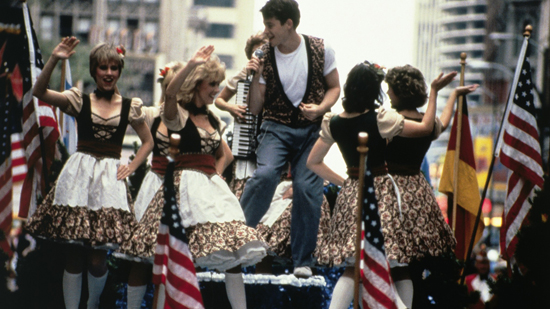
FERRIS BUELLER’S DAY OFF (1986)
“Twist and Shout”
John Hughes movies always incorporate pop music into their soundtracks that work as perfect tone setters, whether they be classic or contemporary. Bands like Oingo Boingo, Simple Minds, and Spandau Ballet got a major boost by having their songs featured prominently in a Hughes flick, but the most memorable musical moment in any of his movies actually takes it’s cue from the greatest rock band of all; The Beatles. In a scene that perfectly illustrates how the character of Ferris Bueller (Matthew Broderick) can charm his way into anything, Ferris is seen taking over a parade float in Downtown Chicago and he manages to lead the parade performers and audience into a playful performance of the Beatles’ “Twist and Shout.” Sure it’s another lip-synching performance, but Broderick puts a lot of energy into it, and in that moment you see the character at his most charismatic. The fun thing about the scene is that it seems to organically change from a spur of the moment routine from Bueller into a full blown movie musical moment, with people in the crowd suddenly staring to dance like they rehearsed it. For a bit, it looks like John Hughes is breaking the veneer of reality a bit by making the sing along feel like a true Hollywood musical. It’s no surprise that Broadrick was and still remains a Broadway musical performer of note, and that talent for musical performance can definitely be seen here. The scene also feels like a love letter to the city of Chicago from John Hughes, who would set most of his movies in the Windy City. Both Los Angeles and New York have been the spotlighted in classic musicals before. With Ferris Bueller, we see the city come alive with it’s own musical spark.
4.

PULP FICTION (1994)
“You Never Can Tell”
One thing that definitely defines the movies of Quentin Tarantino is the soundtrack. And what is particularly interesting about the music in a Tarantino movie is that he doesn’t always pick an obvious, popular song to underscore his scenes. He likes his deep cuts, and it’s often the case where a long buried song from an obscure band may end up being re-discovered by being featured in one of Quentin’s movies. For the most part, he uses music as a tone setter, being a non-diegetic factor in the scenes. But there are instances where he does have his characters reacting to the music they are listening to. In some cases, those songs become such an iconic part of those scenes, that it’s another case where those songs have been imprinted with the movie that they featured in. The torture scene from Reservoir Dogs (1992) with Stealers Wheel’s “Stuck in the Middle With You” is a great example of this, as you can’t listen to the song anymore without picturing Michael Madsen’s little shuffle step before he cuts the policeman’s ear off. But as memorable as that moment is, Tarantino’s most memorable musical moment is found in Pulp Fiction, with John Travolta and Uma Thurman’s iconic dance in the Jack Rabbit Slim’s Twist Contest. Performed to Chuck Berry’s “You Never Can Tell,” their dance is simultaneously absurd and impressive to watch. Travolta’s waving of the two fingers in a “V” across his eyes alone is a shorthand gesture that immediately recalls this film whenever somebody imitates it. In all of Tarantino’s body of work, this is the closest he’s ever come to making an all out musical moment in one of his movies. He probably felt that he had to put a scene like this in a movie that was going to feature John Travolta, the star of Saturday Night Fever (1977) and Grease (1978). And it’s a good thing he did, because in a film full of some pretty dark and harrowing moments, it’s the one part of the movie that just allows itself to have a little fun; and in turn it makes for an unforgettable musical moment.
3.
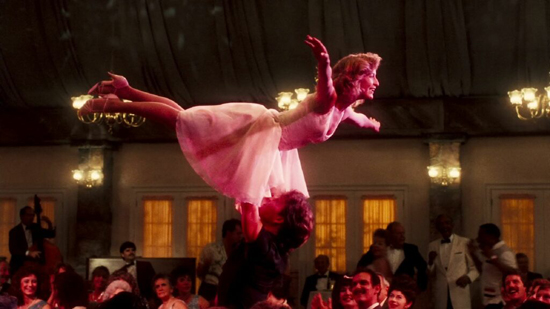
DIRTY DANCING (1987)
“I’ve Had the Time of My Life”
A lot of movies like to finish on a strong note, and in most cases the best way to do that is with music. Dirty Dancing, for most of it’s runtime is a simple romantic melodrama, complete with a soundtrack of 60’s standards to help set the time and place of this movie. But, in the closing scene of the film, when dance instructor Johnny Castle (Patrick Swayze at the top of his game) pushes his top student and love interest Baby (Jennifer Grey) to show off all the dance moves he’s been teaching her in a public gathering, the film suddenly launches into a full musical number that to this day defines it’s era. In contrast with the rest of the movie, the scene is scored not with a classic, era appropriate song but instead with a contemporary 80’s ballad, sung by Bill Medley and Jennifer Warnes. And the film suddenly shifts to staging the shots like it’s a music video. For a film that had been a laid back drama up to this point, this final scene puts a fantastical spin on the moment and in many ways it feels earned. You can definitely feel the shift in the movie when Swayze looks at Jennifer Grey sitting quietly at her table and delivers his now oft quoted line, “Nobody puts Baby in the corner.” And the film just closes out it’s story purely through song and dance from then out, something that the rest of the movie wouldn’t have indicated up to that point. Of course the moment that becomes the highlight of the scene is when Baby perfectly lands the leap into the air, where Johnny holds her aloft over his head. This is a move that has been attempted at many weddings across the world in the nearly 40 years since, to varying degrees of success. It may have been peak 80’s, but it’s a moment that still represents one of the best uses of music to carry a scene and present a grandiose musical moment into a generally straightforward film and help it become something truly cinematic.
2.

BARBIE (2023)
“I’m Just Ken”
It’s actually a bit of a surprise that we got a Barbie movie that wasn’t more musical. This Greta Gerwig directed satirical comedy became a massive box office hit in no small part to it’s perfectly executed concept and hilarious observations about gender roles and the societal pressures that reinforce them. It also had a great soundtrack that surprisingly also contributed to the messages of the movie. Most of the songs are great to listen to, but only one stands out as being a true musical number in this movie. And boy does it stand out. Penned by songwriter Mark Ronson, whose had a hand in many Top 40 hits over the years, this show-stopper is devoted to the Kens that live in Barbieland, and is a tour de force that perfectly toes the line between absurd and sincere, which makes it the perfect encapsulation of the movie itself. Ryan Gosling’s performance completely sells this song. It’s a hilarious parody of a rock opera ballad that is absurdly over the top. While the initial melancholy opening part is hilarious enough, the movie really hits it’s high when we reach the “dance off” portion. From this point, the song goes from absurdly hilarious to epically hilarious, with these wannabe alpha males trying to assert their manhood by way of interpretive dance. In a film that already has plenty of great comedic moment, this is where the movie takes everything to an iconic level. It’s such an imaginative road to take with what is on it’s own a very absurd song. It’s a relatively new entry compared with all the other musical moments on this list, but the fact that it lands so well as both a joke within the scene as well as a sincerely great song on it’s own really has elevated it to being one of the best musical moments of this type. It’s an inspired moment that really punctuates the comedy of it’s film and shows how well an unexpected musical moment can help to elevate the movie as a whole.
1.

THE PRODUCERS (1968)
“Springtime for Hitler”
The legendary Mel Brooks has always tried to work at least one musical number into most of his films. Whether it’s the title number from Robin Hood: Men in Tights (1993), or Lily Von Shtupp’s dance hall routine in Blazing Saddles (1974), or the iconic and hilarious version of “Puttin’ on the Ritz” from Young Frankenstein (1974), he’s always managed to get a musical moment that fits well into his movies that are otherwise more comedically driven. But out of all of his big musical numbers, I don’t think any stands out more than the title number for the intentionally bad stage musical “Springtime for Hitler. In a multi-layered gag, Mel is able to poke fun at the over the top spectacle of musical theater while also getting in his shots at the expense of Hitler and the Nazi Party. There’s actually a profound meaning behind the joke here. Mel Brooks distilled the Nazis down to their pageantry, showing that this was the biggest weapon they had in spreading their propaganda, but when you take that pageantry out of the context of a scary Nazi rally and put it into a Broadway musical spectacle, you really see the absurdity of what it actually was in the end. That’s the genius behind Mel Brooks’ satire in The Producers, that once you strip propaganda down to it’s naked pageantry, you rob it of it’s power by showing how ridiculous it looks out of context. And the musical number “Springtime for Hitler” is a perfect illustration of this, with Nazi’s looking absolutely ridiculous when imagined as chorus line dancers. The best part of the scene is seeing the horrified faces of the Broadway audience; just utterly petrified by the audacity of what they are seeing. Even though the movie centers around musical theater, this is the one true musical number in the movie and it shows the talent that Mel Brooks had in staging a musical sequence for a film, even if the intention was for it to be a joke. Mel would go on to take The Producers and turn it into a stage musical for real many years later, which itself would become one of the most successful Broadway shows of all time. For a musical sequence that appears in a movie that’s not a musical, there really is nothing that quite hits as hard musically or thematically as this one does; a brilliant accomplishment from the comedic and cinematic genius that is Mr. Mel Brooks.
So, there you have my picks for the best musical moments in non-musical movies. There is often a fine line between what we consider to be a true Hollywood musical. Most movies contain great music, but to be a movie musical that music must also be an integral part of the story telling and not just a mood setter. These examples that I spotlighted blur that line even more, because in most cases they are moments that you would normally find in a standard movie musical, and yet they stand alone within their movies. Some were a part of their movie as an intentional parody of movie musical numbers, like with Monty Python‘s “Camelot” or The Producers‘ “Springtime for Hitler.” Other times, it’s just the characters getting into the music they are hearing and that in turn creates an iconic moment on it’s own, like in Risky Business, or Big, or Ferris Bueller’s Day Off. And then there is there’s the coda from Slumdog Millionaire where the movie divorces itself from the grounded story it was telling to give us a fun celebratory dance number to leave the movie on. In all the cases, these scenes used music effectively to embellish their moments, and in turn created iconic moments that made their films even better. Risky Business was defined by Tom Cruise’s bare legged dancing to rock music and Dirty Dancing was defined by that triumphant leap that Jennifer Grey made into Patrick Swayze’s arms, lifted high into the air. And of course Pulp Fiction was given it’s most iconic moment with whatever dance Travolta and Thurman were trying to do in their scene together. All of these show that a movie doesn’t have to be musical in the traditional sense to have a great musical moment. Often these stand out as the best cinema has to offer because of how unexpected they usually are. And the best ones will also sometimes leave their mark on the songs they showcase, like what Wayne’s World did with “Bohemian Rhapsody.” That’s a true sign of the power of music in storytelling. One of the best kinds of surprises you’ll find in watching a movie is seeing how well one song can make a movie shine even brighter when it’s used in the best way possible.